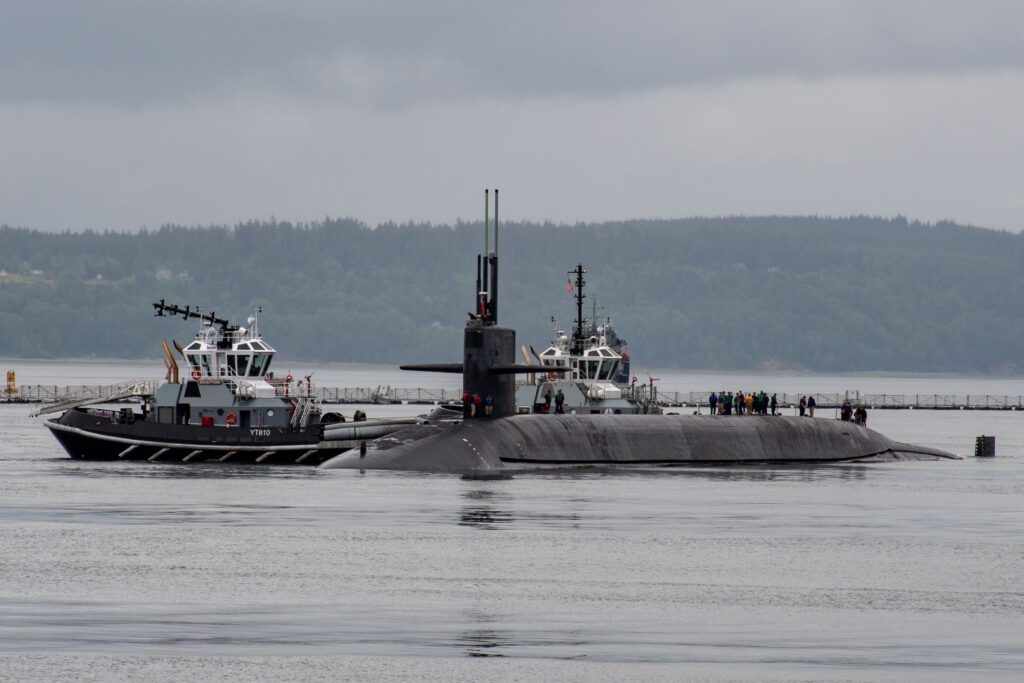The United States has disclosed the movements of its submarines—armed with nuclear missiles—for the second time this month, demonstrating its deterrent capability.
The Submarine Group Ten, which oversees operations of the Atlantic ballistic missile submarine (SSBN) fleet, told Newsweek that it could not discuss submarine schedules or deployments because of operational security concerns. The unit is assigned with six SSBNs.
Why It Matters
The U.S. Navy operates a fleet of 14 nuclear-powered Ohio-class SSBNs, each capable of carrying up to 20 ballistic missiles. Eight of these submarines are based at Bangor, Washington, while the remaining six are homeported at Kings Bay, Georgia.
The SSBN fleet forms part of the U.S.’s “nuclear triad,” alongside strategic bombers and land-based intercontinental ballistic missiles to deter adversaries.
The U.S. Navy rarely publicizes SSBN operations as the submarines are designed for deterrent patrols and launching missiles if necessary. One of the SSBNs, USS Kentucky, conducted an escort drill with helicopters in the Pacific, the Navy said on May 2.
What To Know
In a set of undated photos shared by the Submarine Group Ten on Facebook on May 15, USS West Virginia was seen making final preparations to depart its home port—Kings Bay—for “routine operations” in support of the country’s strategic mission.
The submarine was operated by its “Blue crew,” one of two crew teams that alternate manning it. This two-crew system maximizes the SSBN’s availability and reduces the number of submarines needed to meet strategic requirements, according to the U.S. Navy.
This marked the second publicized departure of the West Virginia in more than two months. The submarine—manned by its “Gold crew”—was seen preparing to depart on March 12 for a strategic mission, according to photos released by the Submarine Group Ten.
Meanwhile, USS Tennessee, another SSBN assigned to the Submarine Group Ten, was seen exiting a dry dock at Kings Bay following “months of hard work” of maintenance, according to an undated short video released on the unit’s Facebook page on Monday.
The Submarine Group Ten told Newsweek that its mission is to deliver “combat ready forces” by ensuring its submarines “are properly manned, trained, equipped and certified to conduct decisive combat operations around the world.”
On the West Coast, the Submarine Group Nine announced that USS Henry M. Jackson, one of eight SSBNs assigned to the unit, returned to its home port at Bangor on May 15 following a routine strategic deterrent patrol, according to photos released on Thursday.
Strategic deterrence relies on a safe, secure and effective nuclear deterrent force, said the Pacific Northwest-based unit, which oversees submarine operations in the region.
What People Are Saying
The U.S. Submarine Group Ten wrote on Facebook: “This is a testament to [Team Kings Bay’s] commitment to keeping our fleet ready and capable. This Ohio-class ballistic missile submarine [USS Tennessee] is one step closer to resuming its vital role in our nation’s strategic deterrence mission.”
The U.S. Submarine Group Nine said on its webpage: “Ballistic missile submarines (SSBNs) serve as an undetectable launch platform for intercontinental ballistic missiles. They are considered the survivable leg of the strategic deterrent triad, the others being long-range manned aircraft and land-based intercontinental ballistic missiles.”
What Happens Next
It remains to be seen whether the U.S. SSBN fleet will conduct any test launches of its submarine-launched ballistic missiles, which can deliver nuclear warheads to targets more than 7,400 miles away, according to the Federation of American Scientists.
Read the full article here
